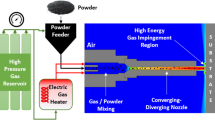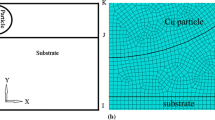Abstract
In cold spray, high gas temperatures and high velocity impact of particles introduce complex thermal and stress histories in the coating layers and the substrate. It is crucial to understand the interplay between temperature evolution and residual stress development as the residual stresses could potentially cause distortion and/or delamination. In this study, a system-level cold-spray deposition model is developed. The model includes a moving heat source, material addition and thermo-mechanical stress analyses. The heat source model is first validated by qualitatively comparing the thermal history with experimental measurements from literature. The system-level model is then used to calculate the residual stresses and distortion in the cold-sprayed Cu/steel system. The influence of the spray path on the residual stress development is systematically analyzed. The corresponding interface residual stress states are also examined for the different spray paths. Simulation results indicate that the thermo-mechanical analysis using the developed system-level model can provide an effective way to assist in optimizing the cold-spray coating deposition strategy and improve the coating performance.














Similar content being viewed by others
Abbreviations
- ε:
-
Emissivity
- \(\sigma\) :
-
Boltzmann constant (1.3806 × 10−23 J/K)
- \(\rho\) :
-
Material density (\({\text{kg}}/{\text{m}}^{3}\))
- \(C_{p}\) :
-
Specific heat capacity (\({\text{J}}/{\text{kg}} \cdot {\text{K}}\))
- \(k\) :
-
Thermal conductivity of the solid materials (\({\text{W}}/{\text{m}} \cdot {\text{K}}\))
- \(\varvec{n}\) :
-
Unit normal vector to the substrate surface
- \(f_{c} ,f_{r}\) :
-
Convective and radiative heat flux (W/m2)
- \(h\) :
-
Heat transfer coefficient used for forced convection (\({\text{W}}/{\text{m}}^{2} \cdot {\text{K}}\))
- \(h_{g}\) :
-
Heat transfer coefficient used in Eq (6) (\({\text{W}}/{\text{m}}^{2} \cdot {\text{K}}\))
- \({\text{Nu}}\) :
-
Nusselt number (\({\text{Nu}} = h_{g} D/k_{g} )\)
- \(D\) :
-
Nozzle diameter (m)
- \(k_{g}\) :
-
Gas thermal conductivity (\({\text{W}}/{\text{m}} \cdot {\text{K}}\))
- \(T_{g}\) :
-
Gas temperature on the substrate surface used in Eq (6) (K)
- \(T_{{}}\) :
-
Substrate temperature (\({\text{K}}\))
- \(T_{\infty }\) :
-
Air temperature (\({\text{K}}\))
- \(T_{s}\) :
-
Radiation reference temperature (\({\text{K}}\))
- \(\dot{Q}_{\text{impact}}\) :
-
Thermal energy generation rate due to the particle impact (\({\text{W}}/{\text{m}}^{3}\))
- \(\dot{E}_{k}\) :
-
Power of particle kinetic energy (\({\text{W}}\))
- \(\dot{m}_{p}\) :
-
Powder feeding rate (\({\text{kg}}/{\text{s}}\))
- \(\overline{{v_{p} }}\) :
-
Averaged particle impact velocity (\({\text{m}}/{\text{s}}\))
- \(R_{e}\) :
-
Kinetic to thermal energy conversion factor
- \(V_{\text{dep}}\) :
-
Volume of deposited coating block (\({\text{m}}^{3}\))
- Y :
-
Yield stress, JC model (Pa)
- A :
-
Initial yield stress, JC model (Pa)
- B :
-
Strain hardening coefficient, JC model (Pa)
- n :
-
Strain hardening exponent JC model
- C :
-
Strain-rate hardening coefficient, JC model
- m :
-
Thermal-softening exponent, JC model
- T r :
-
Reference temperature, JC model (K)
- T m :
-
Melting temperature, JC model (K)
- \(\varepsilon_{\text{p}}\) :
-
Plastic strain, JC model
- \(\dot{\varepsilon }_{\text{p}}\) :
-
Plastic strain rate, JC model
- \(\dot{\varepsilon }_{0}\) :
-
Reference strain rate, JC model
References
T. Schmidt, F. Gärtner, H. Assadi, and H. Kreye, Development of a Generalized Parameter Window for Cold Spray Deposition, Acta Mater., 2006, 54(3), p 729-742
R.C. Dykhuizen and M.F. Smith, Gas Dynamic Principles of Cold Spray, J. Therm. Spray Technol., 1998, 7(2), p 205-212
P. Cavaliere and A. Silvello, Fatigue Behaviour of Cold Sprayed Metals and Alloys: Critical Review, Surf. Eng., 2016, 32(9), p 631-640
R. Ghelichi, D. MacDonald, S. Bagherifard, H. Jahed, M. Guagliano, and B. Jodoin, Microstructure and Fatigue Behavior of Cold Spray Coated Al5052, Acta Mater., 2012, 60(19), p 6555-6561
M. Diab, X. Pang, and H. Jahed, The Effect of Pure Aluminum Cold Spray Coating on Corrosion and Corrosion Fatigue of Magnesium (3% Al-1% Zn) extrusion, Surf. Coat. Technol., 2017, 309, p 423-435
E. Lin, I. Nault, V.K. Champagne, A. Nardi, and S. Müftü, Analysis of Interface Fracture of Cold-Sprayed Coatings Due to Thermal Cycling, J. Therm. Spray Technol., 2019, 29, p 158-172
A.G. Gavras, D.A. Lados, V.K. Champagne, and R.J. Warren, Effects of Processing on Microstructure Evolution and Fatigue Crack Growth Mechanisms in Cold-Spray 6061 Aluminum Alloy, Int. J. Fatigue, 2018, 110, p 49-62
Q. Zhang, C.-J. Li, Y. Li, S.-L. Zhang, X.-R. Wang, G.-J. Yang, and C.-X. Li, Thermal Failure of Nanostructured Thermal Barrier Coatings with Cold-Sprayed Nanostructured NiCrAlY Bond Coat, J. Therm. Spray Technol., 2008, 17(5), p 838-845
Y.C. Tsui and T.W. Clyne, An Analytical Model for Predicting Residual Stresses in Progressively Deposited Coatings Part 1: Planar Geometry, Thin Solid Films, 1997, 306(1), p 23-33
V. Luzin, K. Spencer, and M.X. Zhang, Residual Stress and Thermo-Mechanical Properties of Cold Spray Metal Coatings, Acta Mater., 2011, 59(3), p 1259-1270
E. Lin, Q. Chen, O.C. Ozdemir, V.K. Champagne, and S. Müftü, Effects of Interface Bonding on the Residual Stresses in Cold-Sprayed Al-6061: A Numerical Investigation, J. Therm. Spray Technol., 2019, 28(3), p 472-483
W. Li, K. Yang, D. Zhang, and X. Zhou, Residual Stress Analysis of Cold-Sprayed Copper Coatings by Numerical Simulation, J. Therm. Spray Technol., 2016, 25(1), p 131-142
X. Song, J. Everaerts, W. Zhai, H. Zheng, A.W.Y. Tan, W. Sun, F. Li, I. Marinescu, E. Liu, and A.M. Korsunsky, Residual Stresses in Single Particle Splat of Metal Cold Spray Process—Numerical Simulation and Direct Measurement, Mater. Lett., 2018, 230, p 152-156
D. Boruah, B. Ahmad, T.L. Lee, S. Kabra, A.K. Syed, P. McNutt, M. Doré, and X. Zhang, Evaluation of Residual Stresses Induced by Cold Spraying of Ti-6Al-4 V on Ti-6Al-4 V Substrates, Surf. Coat. Technol., 2019, 374, p 591-602
R. Ghelichi, S. Bagherifard, D. MacDonald, I. Fernandez-Pariente, B. Jodoin, and M. Guagliano, Experimental and Numerical Study of Residual Stress Evolution in Cold Spray Coating, Appl. Surf. Sci., 2014, 288, p 26-33
G. Shayegan, H. Mahmoudi, R. Ghelichi, J. Villafuerte, J. Wang, M. Guagliano, and H. Jahed, Residual Stress Induced by Cold Spray Coating of Magnesium AZ31B Extrusion, Mater. Des., 2014, 60, p 72-84
H. Assadi, F. Gärtner, T. Stoltenhoff, and H. Kreye, Bonding Mechanism in Cold Gas Spraying, Acta Mater., 2003, 51(15), p 4379-4394
F. Hugot, J. Patru, P. Fauchais, and L. Bianchi, Modeling of a Substrate Thermomechanical Behavior During Plasma Spraying, J. Mater. Process. Technol., 2007, 190(1), p 317-323
C. Chen, Y. Xie, C. Verdy, R. Huang, H. Liao, Z. Ren, and S. Deng, Numerical Investigation of Transient Coating Build-Up and Heat Transfer in Cold Spray, Surf. Coat. Technol., 2017, 326, p 355-365
STAR-CCM + Release Notes v11.06, Siemens PLM Software, 2016
ABAQUS/CAE user’s manual: version 6.13: Pawtucket, RI: ABAQUS; 2012
A.N. Ryabinin, E. Irissou, A. McDonald, and J.G. Legoux, Simulation of Gas-Substrate Heat Exchange During Cold-Gas Dynamic Spraying, Int. J. Therm. Sci., 2012, 56, p 12-18
O.C. Ozdemir, Q. Chen, S. Muftu, and V.K. Champagne, Modeling the Continuous Heat Generation in the Cold Spray Coating Process, J. Therm. Spray Technol., 2019, 28(1), p 108-123
T. Suhonen, T. Varis, S. Dosta, M. Torrell, and J.M. Guilemany, Residual Stress Development in Cold Sprayed Al, Cu and Ti Coatings, Acta Mater., 2013, 61(17), p 6329-6337
W.-Y. Li, S. Yin, X. Guo, H. Liao, X.-F. Wang, and C. Coddet, An Investigation on Temperature Distribution Within the Substrate and Nozzle Wall in Cold Spraying by Numerical and Experimental Methods, J. Therm. Spray Technol., 2012, 21(1), p 41-48
A.G. McDonald, A.N. Ryabinin, E. Irissou, and J.-G. Legoux, Gas-Substrate Heat Exchange During Cold-Gas Dynamic Spraying, J. Therm. Spray Technol., 2013, 22(2), p 391-397
Z. Arabgol, H. Assadi, T. Schmidt, F. Gärtner, and T. Klassen, Analysis of Thermal History and Residual Stress in Cold-Sprayed Coatings, J. Therm. Spray Technol., 2014, 23(1), p 84-90
JAHM Software Inc., Material Properties Database, MPDB, Vol. V7.01 demo, 2003
Acknowledgment
This work was sponsored in part by the Army Research Laboratories under the Grant Number W911NF-15-2-0026. Any opinions, findings and conclusions or recommendations expressed in this material are those of the author(s) and do not necessarily reflect the views of the US Government.
Author information
Authors and Affiliations
Corresponding author
Additional information
Publisher's Note
Springer Nature remains neutral with regard to jurisdictional claims in published maps and institutional affiliations.
This article is part of a special topical focus in the Journal of Thermal Spray Technology on Advanced Residual Stress Analysis in Thermal Spray and Cold Spray Processes. This issue was organized by Dr. Vladimir Luzin, Australian Centre for Neutron Scattering; Dr. Seiji Kuroda, National Institute of Materials Science; Dr. Shuo Yin, Trinity College Dublin; and Dr. Andrew Ang, Swinburne University of Technology.
Appendix
Appendix
Two data storage frequencies (4 times and 50 times during a scan) were used to save the temperature and deposition history during heat transfer analysis step, in order to study the effects on the stress development along path-1, in thermo-mechanical simulations. Figure 15 shows that when the storage frequency increases to 50, the discontinuity in the stress along the scan-path is significantly reduced during the immediate scan (first scan), and the stress almost immediately reaches the steady state. The stress is slightly changed after the second scan only near the two edges. These observations confirm that the stress in the newly deposited coating ribbon is mainly determined by the immediate scan and the next scan.
Rights and permissions
About this article
Cite this article
Lin, E., Nault, I., Ozdemir, O.C. et al. Thermo-Mechanical Deformation History and the Residual Stress Distribution in Cold Spray. J Therm Spray Tech 29, 1424–1436 (2020). https://doi.org/10.1007/s11666-020-01034-5
Received:
Revised:
Published:
Issue Date:
DOI: https://doi.org/10.1007/s11666-020-01034-5





